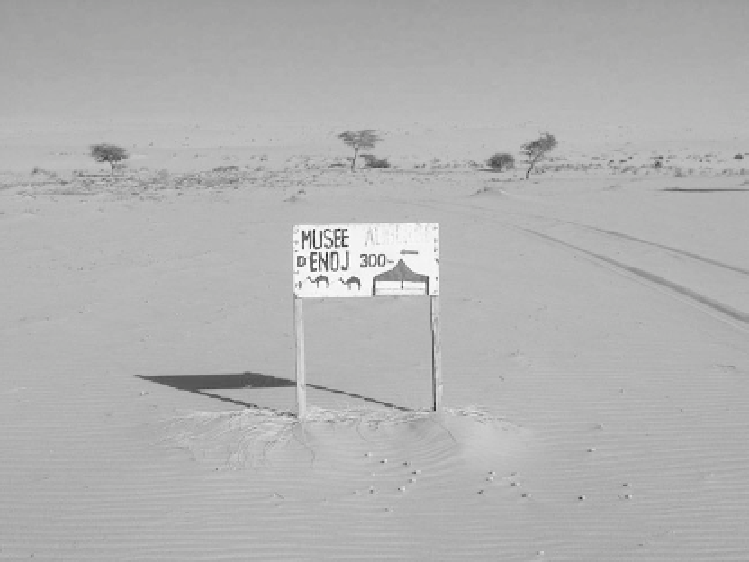Travel Reference
In-Depth Information
Fig. 15.2.
Desert displays. Copyright Maria Cardeira da Silva, CEAS/CRIA, FCT.
In the specifi c case of Ouadane, something
else has contributed to its touristic capitalization
and to place it on the tourist route: this was the
construction of the walls around the ruins of the
ancienne ville
(Figs 15.3 and 15.4).
The construction of these walls was subsi-
dized under the scope of a bilateral co-operation
agreement signed by the Portuguese and the
Mauritanian governments. Such co-operation
was inspired by the idea that the Portuguese
had built a trading post there in the 15th century
in order to intercept the caravans of Saharan
merchants (something still to be archaeologi-
cally confi rmed). In fact, the construction of the
walls has played an important role in the tour-
istic promotion of Ouadane, since it permitted
a new reading of the landscape: something
which used to be a pile of stones became 'ruins'
and earned a symbolic density that enabled it
to be transformed into a touristic attraction. A
touristic attraction that appeals to the preserva-
tionist rationale, the salvage impulse (Butcher,
2003) that leads most tourists to Ouadane.
Those ruins are the remains of a past that
deserves all efforts to preserve it, since it sup-
ports the identity of cultures: remains of culture.
What most tourists are not aware of is that,
although Ouadane has obviously its own his-
tory that it strives to save - and now to display
as merchandise for tourists - the type of con-
struction that the walls signal and preserve - a
ksur
- was not necessarily enclosed by walls
(Cheikh
et al
., 2002). This type of urban gath-
ering was adapted to the seasonal rhythms and
fl ows of its inhabitants who lived mostly from
long-distance trade and grazing and, therefore,
a
ksur
was made of perishable constructions,
since its population was relatively mobile. Con-
structions and ruins were intertwined. In any
given moment, the ruins made part of the pres-
ent of the town, whose inhabitants did not
waste much effort rebuilding what time or the
unpredictable force of the river (
uad
) destroyed
every year. Moreover, the several drought peri-
ods (in the 1960s and 1980s) and subsequent
urban migration, the war between Mauritania
and Senegal in 1989 and, with more direct
effects over Ouadane, the Sahara war, all con-
tributed to its
natural urban decadence
(at that
time, Ouadane had barely over 100 inhabit-
ants). And when, at the beginning of the 1990s,
some of the country's more distinguished patri-
cians returned, in part attracted by the cultural
capitalization of their homeland, they were

Search WWH ::

Custom Search